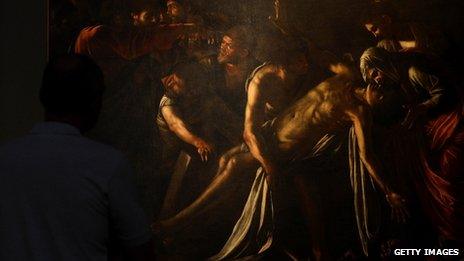Restored Caravaggio's Lazarus is shown in Rome
- Published

The Resurrection of Lazarus depicts the story in the Gospel of St John in which Jesus raises Lazarus from the dead.
Caravaggio's Resurrection of Lazarus has gone on display in Rome, after seven months of restoration work.
The painting, also known as The Raising of Lazarus, is believed to have been painted in 1609, one year before the artist's death at the age of 38.
It depicts the story in the Gospel of St John in which Jesus raises Lazarus from the dead.
It marks the first time the painting has been restored in 60 years. It will remain in Rome until 15 July.
The painting was housed for centuries in the church of the Crociferi fathers in Messina, Sicily, before it was moved to the city's museum.
It shows the instant that Christ points to the dead Lazarus - who is being held in the arms of those who exhumed him - and brings his friend back to life.

Caravaggio's 'Lazarus' before and after its restoration in Rome
The background of the painting is mostly dark, which art historians say was probably because Caravaggio was in a hurry to complete the commission.
"During this period of his life, Caravaggio was forced to finish his paintings very quickly, and therefore he refined his technique in order to achieve this objective," said restorer Anna Maria Marcone.
"He used local materials and used the dark background in order to quickly realise the figures," she told a news conference.
The painting was done on six pieces of canvas - five vertical and one horizontal - that were sewn together to reach the desired size.
Marcone said the most difficult part of the restoration was repairing some of the damage done by what was believed to have been the first restoration on the painting, in 1670.
The painting was unscathed in the great Messina earthquake of 1908, which killed some 200,000 people and destroyed thousands of buildings in Sicily and Calabria.
It will be on display in Rome's Palazzo Braschi, overlooking Piazza Navona, until mid July, when it will be returned to Sicily.